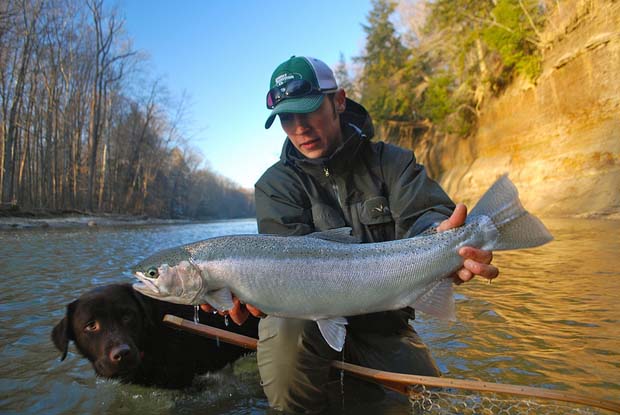Thursday Tip: The Right Gear for Great Lakes Steelhead
Here’s a real piece of great information, written well and covers all you need to know about swinging and single handed casting to Lake Erie steelhead. Jim covers rods, reels, fly lines, terminal tackle and indicator technique, swung-fly technique and flies.
Written by:
Jim Lampros, Fishing Manager of ORVIS Cleveland

The author shows off a big Great Lakes steelhead, as his fishing buddy looks on.
Photo courtesy Jim Lampros.
[dropcap]T[/dropcap]he rise in popularity of the Lake Erie steelhead fishery over the last decade has been well deserved. Erie and her tributaries unequivocally offer the best chance, be it East or West, for an angler to get his or her steelhead fix. The availability of public access, the proximity of the fishery to urban centers, and the fact that all of the important tributaries can be fished without the aid of watercraft make these steelhead some of the most accessible in the world. And though this accessibility can make for crowded rivers, solitude can be found with just a little leg-work. Add to the mix the diversity of water and fisheries offered by neighboring Lakes Michigan and Ontario, and you’ll find that Midwestern steelhead anglers face a remarkably unique and diverse array of angling opportunities. Such diversity calls for gear and tactics to match, and after years of tinkering and exploring on these waters, I’ve settled on some favorites which I’ve outlined for you below, along with my rationale for each recommendation.
RODS
10-foot 7-weight
11-foot 6-weight switch
To choose the right rod/s for Midwest steelheading, you must take into account two critical components: the size and character of the average river, and the tactics you plan to employ. As size and character go, the average Midwest steelhead stream is relatively small and shallow. They are therefore fished most effectively with single-hand rods and subsurface nymphing or dead-drift presentations. In other words, all things being equal, if I have to put a fish in the net, I’m going with a 10-foot 7-weight rod and a two-fly indicator nymph rig, which I’ll explain in detail later.
The 10-foot rod offers advantages over traditional 9-footers in the form of better mending/line control, easier roll/single-hand-Spey casting and more substantial butt sections for fighting powerful fish. I find that rods longer than 10-feet to be a little clumsy when fished single handed, which is why I prefer the 107 for this technique. That said, a 10-foot 8-weight might be a better choice for Michigan or Ontario tributaries where average fish size tends to be a bit bigger.
I find that the most enjoyable way to take these fish is with short Spey or switch rods and swung-fly presentations. When paired with short, heavy Skagit or Scandinavian lines and sinking tips, these rods load quickly and efficiently with minimal line out and allow anglers to utilize a wide spectrum of casting styles, including both traditional and modern Spey casts. For my home water, I prefer the 116 for two primary reasons: it loads and casts well at distances as close as 35 feet, but has the power to cast much farther when needed. Second, it makes fighting the average 5- to 6-pound steelhead more challenging and more enjoyable than heavier 7- and 8-weight models (though those rods have their place on bigger water such as New York’s Salmon River or Michigan’s Muskegon). Switch rods are outstanding fish-fighting tools and offer the added functionality of single-hand fishing when warranted.
Be sure to check out Jim’s top 10 steelhead flies for Lake Erie.
Don’t miss reading complete story – click here […]

